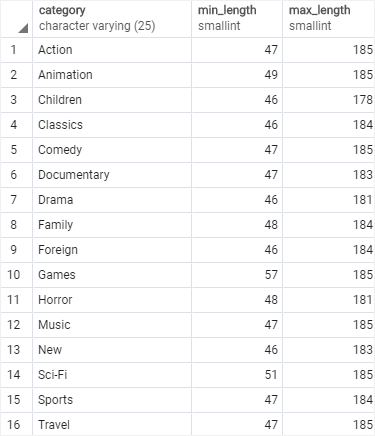August 3, 2023
Summary: In this tutorial, you will learn how to use PostgreSQL MIN() function to get the minimum value of a set.
Table of Contents
Introduction to PostgreSQL MIN function
PostgreSQL MIN() function an aggregate function that returns the minimum value in a set of values.
To find the minimum value in a column of a table, you pass the name of the column to the MIN() function. The data type of the column can be number, string, or any comparable type.
The syntax of the MIN() function is as follows:
SELECT
MIN(expression)
FROM
table_expression
...;
Unlike the AVG(), COUNT() and SUM() functions, the DISTINCT option does not have any effects on the MIN() function.
PostgreSQL MIN() function examples
We will use the film , film_category, and category tables from the dvdrental sample database for demonstration.

1) Using PostgreSQL MIN function in SELECT clause
The following example uses the MIN() function to get the lowest rental rate from the rental_rate column the film table:
SELECT
MIN (rental_rate)
FROM
film;

The query returns 0.99, which is the lowest rental rate.
2) Using PostgreSQL MIN function in a subquery
To get films which have the lowest rental rate, you use the following query:
SELECT
film_id,
title,
rental_rate
FROM
film
WHERE
rental_rate = (
SELECT MIN(rental_rate)
FROM film
);

How it works.
- First, the subquery to select the lowest rental rate.
- Then, the outer query selects films that have rental rates equal to the lowest rental rate returned by the subquery.
3) Using PostgreSQL MIN function with GROUP BY clause
In practice, you often use the MIN function with the GROUP BY clause to find the lowest value in each group.
The following statement uses the MIN() function with the GROUP BY clause to find the lowest replacement cost of films by category:
SELECT
name category,
MIN(replacement_cost) replacement_cost
FROM category
INNER JOIN film_category USING (category_id)
INNER JOIN film USING (film_id)
GROUP BY name
ORDER BY name;

4) Using PostgreSQL MIN function with HAVING clause
It’s possible to use the MIN function in the HAVING clause the filter the groups whose minimum values match a certain condition.
The following query finds uses the MIN() function to find the lowest replacement costs of films grouped by category and selects only groups that have replacement cost greater than 9.99.
SELECT
name category,
MIN(replacement_cost) replacement_cost
FROM category
INNER JOIN film_category USING (category_id)
INNER JOIN film USING (film_id)
GROUP BY name
HAVING MIN(replacement_cost) > 9.99
ORDER BY name;

5) Using PostgreSQL MIN function with other aggregate functions
It’s possible to use the MIN() function with other aggregate functions such as MAX() function in the same query.
The following example uses the MIN() and MAX() function to find the shortest and longest films by category:
SELECT
name category,
MIN(length) min_length,
MAX(length) max_length
FROM category
INNER JOIN film_category USING (category_id)
INNER JOIN film USING (film_id)
GROUP BY name
ORDER BY name;

6) Finding the smallest values from two or more columns
Suppose, you have the following ranks table:
CREATE TABLE ranks (
user_id INT PRIMARY KEY,
rank_1 int4 NOT NULL,
rank_2 int4 NOT NULL,
rank_3 int4 NOT NULL
);
And its sample data:
INSERT INTO ranks
VALUES
(1, 6, 3, 5),
(2, 2, 8, 5),
(3, 5, 9, 8);
Suppose you need to find the smallest rank for each user:

In this case, you cannot use the MIN() function because the MIN() function is applied to rows, not columns. To find the minimum value of two or more columns, you use the LEAST() function:
SELECT
user_id,
LEAST (rank_1, rank_2, rank_3) AS lowest_rank
FROM
ranks;
The query returns the result as we expected.
Summary
- Use the
MIN()function to find the lowest value in a set of values. - Use the
MIN()withGROUP BYclause to find the lowest value in a group of values. - Use the
LEAST()function to find minimum values between columns.
See more
PostgreSQL Tutorial: Aggregate Functions
PostgreSQL Documentation: Aggregate Functions

